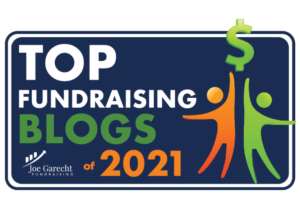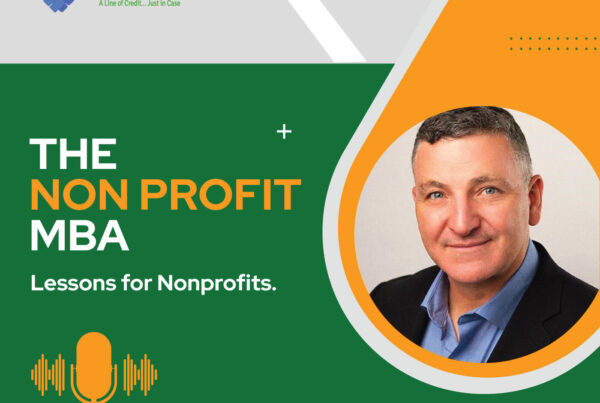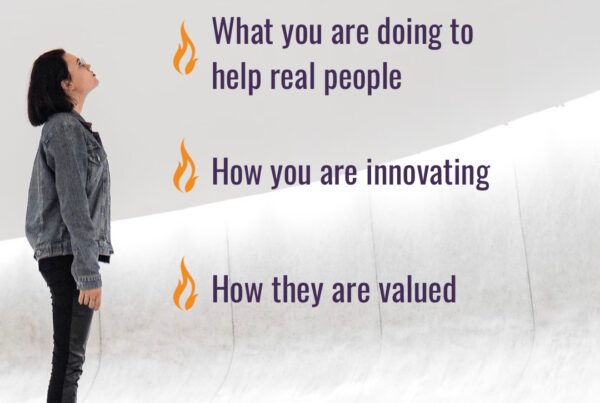This week I’ve got a special guest post by Jay Love, Co-Founder and current Chief Relationship Officer at Bloomerang.
As a nonprofit professional, you know the value of building donor relationships. Impactful relationships keep your supporters coming back year after year to continue contributing to and engaging with your organization’s mission.

However, even the best fundraising professionals out there have probably groaned when it’s time to check off things like “send thank you letters” from their to-do list. Thank you letters are a necessary aspect of building relationships, and you can take these connections to the next level by focusing on strategies that encourage personal connections. This makes showing appreciation and encouraging engagement more enjoyable for both fundraisers and donors alike.
In this guide, we’ll dive into four concrete strategies that can help your team cultivate personal connections with donors, elevating relationship building from just another task on your to-do list to a strategic process that brings joy to everyone involved. We’ll cover the following tactics:
- Create a first-time donor segment.
- Engage your monthly supporters.
- Go above and beyond with appreciation.
- Ask your donors for their opinions.
Ready to make the most of donor relationships and raise more for your organization? Let’s get started.
1. Create a First-Time Donor Segment
Your donors’ first impression of your nonprofit matters. Not just because their first impression drives them to complete their first donation, but also because it sets the foundation for securing the second donation.
The second gift that supporters give to a nonprofit is referred to as the “golden donation” for retaining that donor for the long haul. This is because donors are much more likely to continue giving to your organization after they’ve contributed their second gift. The following graph shows that the average new donor retention rate is only around 20% while the repeat retention rate is closer to 61%. That’s a big difference!
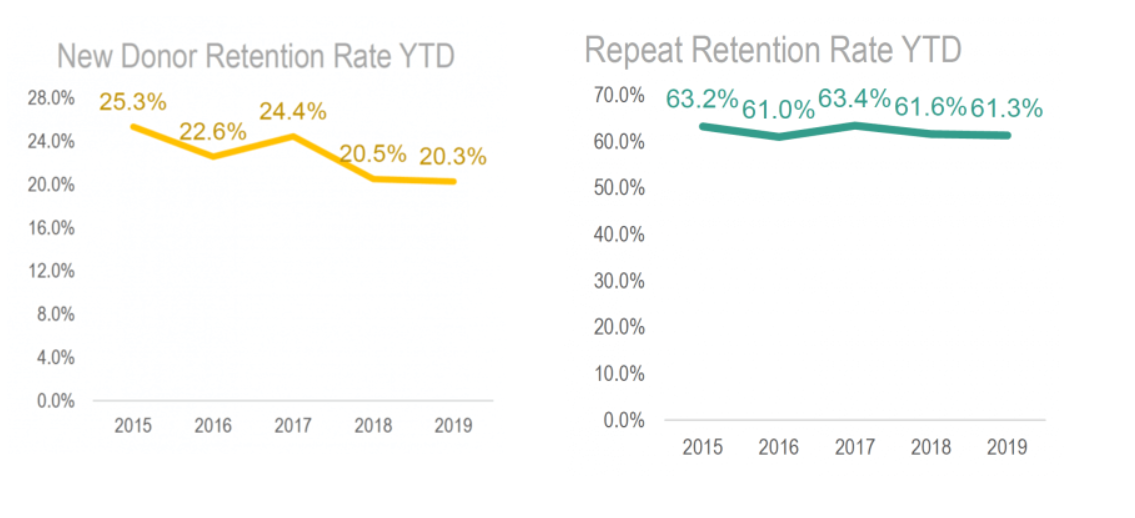
By using your CRM to segment your first-time donors, you form a strategy to drive these supporters toward their second donation.
Tailoring your approach to first-time donors is the fastest way to retain more supporters and improve your overarching retention rate. Some strategies you might consider to leverage your new donor segment include:
- Sending an immediate thank you email to confirm that you’ve received and appreciate the donor’s gift.
- Sending educational materials to new donors such as a welcome letter or past newsletters.
- Calling your donors to thank them for their initial contribution.
- Sending a survey to ask supporters about their initial experience with your nonprofit.
- Providing a list of upcoming activities, events, and advocacy campaigns that the donor can get involved with.
- Finally, asking a donor for their second contribution within 90 days of their first gift.
We recommend creating a first-time donor timeline, listing each of the activities you’ll approach your new donors with and in what order. This will help you create a structured process for showing these crucial donors special attention and giving them the resources they need to better understand your organization.
2. Engage Your Monthly Supporters
When supporters sign up for your monthly donation program, you no longer need to prompt them for gifts on a regular basis. Every once in a while, you might ask them to increase their donation amount or to give an additional gift for a specific campaign. However, the last thing you want to do is make these valuable supporters feel like ATMs for your cause.
Therefore, instead of relying on frequent fundraising asks, your organization should engage recurring donors by providing other opportunities to keep them involved with your mission. This builds a bond between them and your nonprofit, increasing their sense of connection to the cause.
You can encourage your supporters to get involved with your organization by offering a variety of activities, such as:
- Volunteer opportunities. Ask your monthly donors to volunteer at your next event or campaign. Provide a couple of campaigns to choose from so supporters can volunteer for the program that most interests them.
- Advocacy campaigns. Advocacy campaigns provide a concrete way for supporters to give back by helping your organization raise awareness for specific legislation. Ask supporters to sign your petitions, participate in click-to-call campaigns, and promote your digital advocacy efforts on social media.
- Matching gifts. According to 360MatchPro’s matching gift statistics article, 84% of donors are more likely to give when they know their gift will be matched. This means, they’ll engage more with your organization if they know their company will help them increase their impact. Therefore, asking about matching gifts encourages monthly giving supporters to take their current donations a step further to increase their impact.
- Peer-to-peer fundraising. Ask your monthly supporters to raise money on your organization’s behalf in a peer-to-peer fundraising campaign. These campaigns empower your supporters to share your mission and how it impacts them personally with their friends and family while raising funds for your cause.
Monthly donors are key supporters because they provide a sustainable source of income for your nonprofit. Avoid taking the “set it and forget it” approach with them to ensure they never forget your mission.
Instead, build engagement opportunities into your donor relationship development plan. Bloomerang’s development plan template can help you create an actionable plan for strengthening your recurring gift program long term. Creating a plan will help you determine your recurring gifts’ current impact and how to improve relationships with these supporters.
3. Go Above & Beyond with Appreciation
Supporters often stop giving to nonprofits due to poor communication and a lack of donor appreciation from the nonprofit. The following graphic shows why donors lapse when giving to nonprofits:
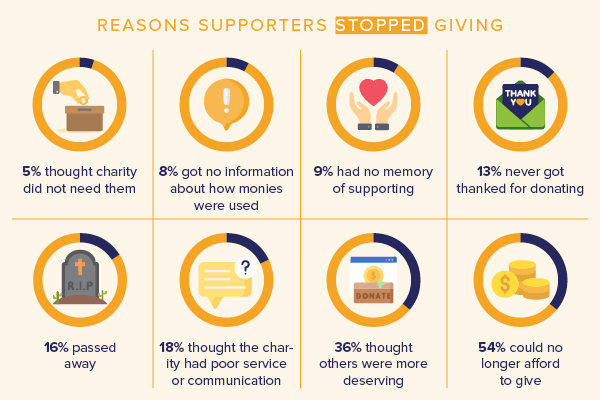
As you can see, many of these reasons for lapsing could be solved by a more thoughtful appreciation strategy, for instance:
- By communicating the impact of gifts in your appreciation strategy, you can address the 5% of donors who lapse because they thought the charity didn’t need them, the 8% of donors who lapse because they don’t know how the money was used, and the 36% of donors who thought others were more deserving.
- Going above and beyond by following up to say thank you in multiple ways, then continuing to reach out to supporters will address the 9% of donors who have no memory of supporting, the 13% who were never thanked for their donation, and the 18% who believed the charity had bad communication.
Every nonprofit should send an immediate thank you email to supporters who give online. Generally, these messages can be automated by your giving tool. However, we believe that you should take your appreciation further to stand out from the crowd and acknowledge supporters.
You can show further appreciation for your supporters by:
- Writing handwritten thank you notes. These letters should be addressed to the correct recipient, sent in a timely manner, and remind your supporters about your mission. Be sure to include an impact statement for your supporters after your campaign so that they know the concrete difference their gift made for your mission.
- Hosting appreciation events. Host events like luncheons or dinners specifically to thank your donors. When you host these events, avoid asking for money to focus entirely on your donors’ past generosity.
- Providing trinkets and gifts. To recognize donations, try sending something back. A t-shirt, magnet, keychain, or sticker can show your supporters that you care about them. Plus, if you brand these items to your nonprofit, they’ll also serve as a reminder about your cause and help promote your brand.
- Calling donors. While most nonprofits will send an email to say thank you, not many fundraising professionals think to pick up the phone and call. Calling donors is a unique sign of appreciation that allows you to converse one-on-one with supporters.
Saying thank you in abundance impresses upon supporters how appreciative you are of their generosity. These relationship-building strategies encourage donors to continue making an impact alongside your organization.
4. Ask Your Donors for Their Opinions
Send out surveys to your nonprofit’s supporters asking them about their experiences with your organization. While not everyone will respond, the gesture still shows your supporters that you care about their thoughts and opinions. This strategy also offers several benefits for nonprofits, including:
- Encouraging active participation among your supporters. By sending out a survey, you’re providing an additional engagement opportunity for your supporters beyond donating.
- Providing actionable ways that you can improve your organization. Supporters have good ideas! By listening to them and implementing some opportunities for improvement, you’ll reinforce the idea that you listen to supporters while potentially making organizational changes for the better.
When crafting your surveys, be sure they’re short and to the point to encourage supporters to fill them out. Long surveys may result in supporters abandoning the opportunity. Provide just a handful of questions and make them multiple choice or ranking 1-10. Then, if you decide to include one or two short answer questions, be sure to place them last on the survey. That way, your supporters will already be invested in completing the survey.
Surveys help donors stick around because they show how much you care about both the supporters themselves and their opinions for your organization. You’ll probably even find some useful tips to improve your offerings!
As a nonprofit professional, you understand the power and importance of connecting with your donors. It’s what brings them back to your cause again and again. If you already have an effective relationship-building strategy, take it to the next level with these tips. You’ll be surprised how much room your organization still has for growth and how you can achieve that growth with the right donor relationship strategy!
About Our Guest Writer
 Jay Love, Co-Founder and current Chief Relationship Officer at Bloomerang
Jay Love, Co-Founder and current Chief Relationship Officer at Bloomerang
He has served this sector for 33 years and is considered the most well-known senior statesman whose advice is sought constantly. Prior to Bloomerang, he was the CEO and Co-Founder of eTapestry for 11 years, which at the time was the leading SaaS technology company serving the charity sector. Jay and his team grew the company to more than 10,000 nonprofit clients, charting a decade of record growth
He is a graduate of Butler University with a B.S. in Business Administration. Over the years, he has given more than 2,500 speeches around the world for the charity sector and is often the voice of new technology for fundraisers.

